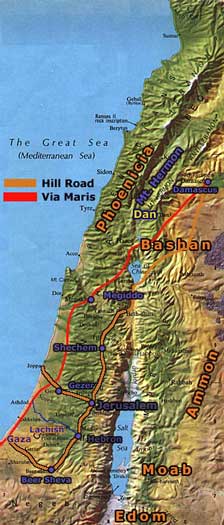Ancient Jewish History: Via Maris
 |
One of the most important trade routes in the Middle East during ancient times was the Via Maris. The Latin term, meaning "Way of the Sea" is referenced in Isaiah 8:23 in the Tanakh (in the Christian Old Testament it is Isaiah 9:1) as "Derech HaYam" or "Way of the Sea." The Latin name comes from the Vulgate, the Latin translation of the New Testament, in Matthew 4:15. The term "Via Maris" comes from the Romans and hence the terminology "Via Maris" tends to be an exclusively Christian reference to the Sea Road. Other names for the Derech HaYam/Via Maris include "Coastal Road" and "Way of the Philistines." From the coast to Damascus, the route is called the Trunk Road. The Via Maris travels and is also known as the International Coastal Highway. The International Coastal Highway is still a major route in modern-day Israel.
The "Way of the Sea" is one of three major trade routes in ancient Israel – the Via Maris, Ridge Route, and the King's Highway. It is situated from the Galilee to the North to Samaria to the South, running through the Jezreel Valley. At the Philistine Plain, the Way broke into two branches, one on the coast and one inland (through the Jezreel Valley, the Sea of Galilee, and Dan), which unites at Megiddo ("Armageddon"). The location of Megiddo vis a vis the Via Maris explains why Megiddo was a very important route for travel and trading city in ancient Israel. The Way of the Sea connected the major routes from the Fertile Cresent to Mesopotamia (from Egypt to modern day Iran, Iraq, Turkey and Syria).The road was the main thoroughfare running north/south from the Sinai along the coastal plain through the Jezreel valley, Beit Shean and on until Damascus
Throughout the centuries, once the Jews were exiled from Israel, the Jezreel Valley, in which the route traverses, became abandoned and the area became an infested swamp. Zionist pioneers, however, drained the swamp from the time of the first land acquisition in 1921, and the valley has been transformed into a fertile, fruit-bearing plain.
Sources: Way of the Sea, WZO, Wikipedia, BibArch; Maps Courtesy of BibArch and the WZO


